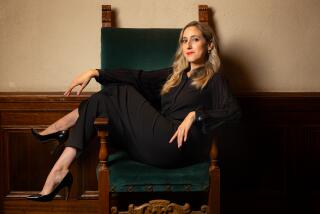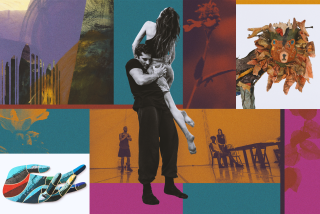Ultima Vez takes unexpected paths
- Share via
Belgian choreographer Wim Vandekeybus creates a world of brutality, fantasy, social and personal struggle, and the primordial urge to create structures whether or not they develop in the direction intended. Most often, they don’t. But that doesn’t negate the fascination in watching the process.
All this was on view Friday at Royce Hall, UCLA, where Vandekeybus’ company, Ultima Vez, danced “Spiegel” (German for “Mirror”), a roughly 90-minute retrospective based on excerpts from half a dozen of the choreographer’s works dating from 1987 to 2000.
Because the company has performed in Los Angeles only twice in the last 17 years, virtually all of the pieces were unfamiliar, although every one had a provocative title: “What the Body Does Not Remember,” “Inasmuch as Life Is Borrowed,” “Immer das Selbe gelogen” (Always the Same Lies) and so on. “Always the Same Lies,” incidentally, was danced at Occidental College in 1991.
Critics attending Friday got a crib sheet identifying the dancers, excerpts and changes made from the original versions, but UCLA Live left out such vital information from the program booklet, so the audience was on its own.
The crib sheet provided pithy and direct scene titles: “Stomping,” “Pushing,” “Girls,” “Boys, “Stones,” “Feather,” “Oranges,” “Blood” and so forth. They were accurate nutshell descriptions, but almost all of the scenes unfolded in arresting, unexpected and witty ways.
“Boys,” for instance, involved burlesque exchanges of costume, in this case seemingly identical suit jackets, which the five guys struggled over and compared before pairing off in stylized boxing rituals. All the while, the Belgian pop group Arno & Ad Cominotto was warning that someone, presumably consumer society, was “going to take your soul.”
Dancing in front of them, the red-clad Ulrike Reinbott wrung her hands and stretched her arms in protest to the heavens and the Earth, but her warnings went unheeded.
“Spiegel” opened with one dancer after another lying on the floor, having to roll clear of others who were trying to stomp on them. This segment segued into a sequence in which dancers who were crawling across the stage pushed into one another’s shoulders until they arched up into dynamic structures wholly dependent on mutual support.
That anticipated other sections, including “Stones,” in which the joy, play and danger of laying the foundation of a building involved split-second dodging of bricks hurtled across the stage or tossed in the air. Yet the segment ended in a joke about classical statuary, with one dancer taking the pose of a Grecian discus thrower, then running to jump onto another in a final mock pose.
The other humorous sections included “Feather,” in which Manuel Ronda kept a feather aloft by puffing on it. (When the feather momentarily drifted out over the front rows, a helpful audience member blew it back onto the stage.)
But things took a very dark turn toward the end (“Blood”) when the dancers hung on grappling hooks or mimed slitting their own or others’ throats or tearing out their hearts in a guilt-shared ritual.
The close of that section, in which most of the dancers took off their clothes, coyly facing away from the audience, and hung them on the hooks seemed inconclusive and strange. It wasn’t clear what Vandekeybus was saying about these perpetrator-victims.
The choreographer himself was the foot-stamping, snorting horse that closed “Spiegel” by lying down to sleep. Maybe this was all supposed to be a dream, or possibly the only escape is in sleep. But cute as it was, the ending also was a bit of a cop-out.
--
More to Read
The biggest entertainment stories
Get our big stories about Hollywood, film, television, music, arts, culture and more right in your inbox as soon as they publish.
You may occasionally receive promotional content from the Los Angeles Times.










